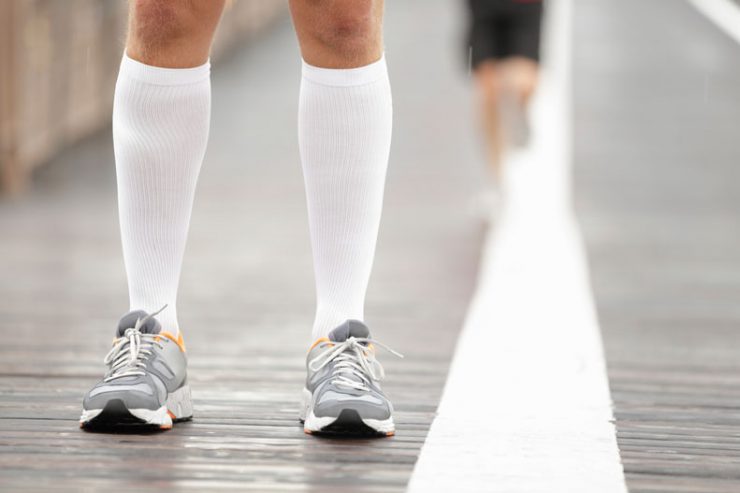Whether you’re a serious athlete or simply a weekend warrior, there are many benefits to wearing compression garments while exercising. The experts at UPMC Sports Medicine weigh in on the types and benefits of compression gear.
Benefits of Compression Gear
Compression garments provide athletes with various health and performance benefits. By applying a balanced surface pressure to specific body parts, compression garments trigger the acceleration of blood flow and increase oxygen delivery to specific muscle groups. This allows athletes to work at a higher rate for a longer period of time, and circulation improvements help the body to recover faster by reducing the build-up of lactic acid. Additional benefits of compression gear include:
- Reduced muscle oscillations and vibration in skeletal muscles during training and competition
- Helping to prevent injury by reducing the amount of damage that can occur to muscles when they shake on impact
- Reduced muscle fatigue and soreness during and after workouts
- A higher SPF factor than conventional athletic apparel
- Reduced chafing in sensitive areas
- Increase circulation which can reduced muscle fatigue and soreness during and after workouts”
Melissa McLane, DO, at UPMC Lemieux Sports Complex explains that compression gear can be used throughout the year in various situations and is a big proponent for compression, even for specific injuries.
Types of Compression Gear
There are two main types of compression used in apparel.
- Compartmental compression – tighter in particular areas and usually tailored for specific sports.
- Graduated compression – tighter in the extremities and used to help increase blood flow back to the core during workouts.
Anyone can benefit from the use of graduated compression, especially those who spend a lot of time in sedentary sitting or standing positions.
Compression clothing often comes in several different forms including skull caps, arm sleeves, long-sleeved tops, vests, tights, calf sleeves, stockings, and socks. These garments are made from a blend of spandex and nylon, and yield different results such as:
Compression gear for the upper body
Wearing a tight, supportive compression shirt after exercising can cut down on swelling and inflammation of the upper body.
Compression gear for the quads, glutes, and hips
Compression tights and shorts can help circulate blood back to the heart, minimizing fatigue.
Compression gear for the calves
Compression socks or calf sleeves can reduce the risk of deep vein thrombosis, a blood clot usually found in the leg, by preventing swelling. The pressure created from these types of garments can also alleviate the following:
- Tired, aching legs
- Swollen ankles
- Leg swelling
- Varicose veins
- Venous insufficiency
- Post-thrombotic syndrome
- Healed venous ulcer
Levels of Compression
There are four main levels of compression, which are measured in millimeters of mercury (mmHg):
- Mild compression: 8-15 mmHg
- Moderate compression: 15-20 mmHg
- Firm compression: 20-30 mmHg*
- Extra Firm Compression: 30-40mmHg*
*Firm and extra firm compression garments should only be worn after receiving medical advice and are available with a prescription.
For the healthy athlete, mild compression garments are great before, during, and after workouts. Moderate compression garments should only be worn during exercise. Higher levels of compression can result in swelling if not used properly. Compression garments are not designed to be worn while sleeping. You should always consult with a physician before wearing compression to bed.
It is always best to check with your doctor so you are aware of any personal risk factors when using compression gear. For more information on improving athletic performance, visit the UPMC Sports Medicine website. To schedule an appointment or for more information, call 1-855-93-SPORT (77678).
